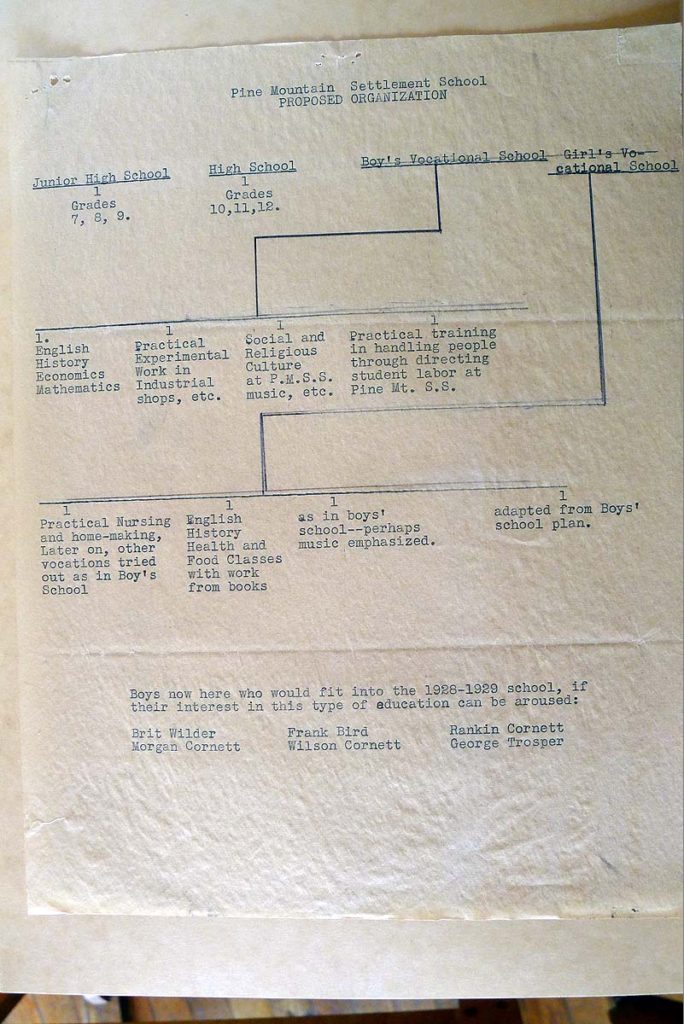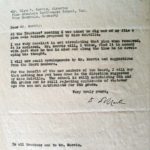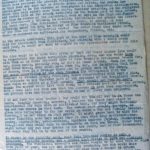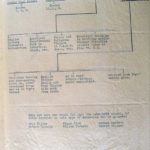Pine Mountain Settlement School
Series 09: BIOGRAPHY – Staff
Series 13: EDUCATION
Angela Melville
1929 Educational Plan

p. 05 1929 Angela Melville Educational Plan. [P1050722.jpg]
TAGS: Angela Melville, educational plan, Darwin D. Martin, curriculum changes, Glyn Morris, progressive educational reform, PMSS Board of Trustees, Consumer Co-op program, Community Service program, boarding school, vocational education
ANGELA MELVILLE 1929 Educational Plan
Like many teaching employees at Pine Mountain Settlement School, Angela Melville was asked to develop a plan for her educational program. Unlike many educational plans that focus on a program of discrete subject areas, Miss Melville’s plan was more far-reaching and integrated in its concepts.
MELVILLE 1929 EDUCATIONAL PLAN: The Board’s Response
The March 15, 1929, plan had been sent to Darwin D. Martin, then Chair of the Pine Mountain School Board of Trustees, during a time of transition at the School. He had not forwarded it on to others on the Board, He appeared to believe that no long-acting curriculum change would be productive, as Angela Melville’s position as the new associate director, charged with the educational program, was an interim position and not likely to persist. Melville had been appointed by the board to fill the void left by the death of Ethel de Long Zande in April 1928.
Zande had planned and directed all educational and institutional programming since the School’s founding in 1913. However, when Glyn Morris came on as the new Director of the School in 1931 and as Katherine Pettit phased out her responsibilities and retired in 1938, Martin sent Morris a copy of the Melville plan with a note that he believed that Morris would “find it in accord with just what he [Morris] has in mind and along the line he is developing his thought.” Morris clearly derived strength for his progressive educational reform from the Melville document.
Mr. Martin at this point sent Melville’s proposed plan for revising the curriculum to the Board
For the benefit of the new members of the Board, I will say that nothing has yet been done in the direction suggested by Miss Melville. The school is still maintaining 5th and 6th grades and is still rejecting applicants of whatever age who can not matriculate for 5th grade.
MELVILLE 1929 EDUCATIONAL PLAN: Influence on Glyn Morris
While Morris did not readily adopt the Melville plan, he certainly borrowed from it and the Morris’ plan is an enhanced Melville plan. But, Morris’ enhancements resulted in an educational plan that was not tied to conventional age and performance standards as they were in the original proposal. Further, the hybrid plan proved to be very effective in the supportive and communitarian environment that Morris was creating. The School’s innovative curriculum was attracting national attention and the programs that Morris developed for the youth of the Appalachian region during his tenure remained through 1949 when the School ended the boarding school program.
Morris was a forceful leader, but the preliminary work that Melville began persisted until the end of the boarding school cycle. Noteworthy is the emphasis on vocational training and the continuance of the Consumer Co-op program which Morris adopted and expanded by adding a robust Community Service program.
Transcription and images of the Angela Melville educational plan follow.
CORRESPONDENCE
Letter from Darwin D. Martin to Glyn Morris. Dec. 16, 1931.
Dear Mr. Morris:
At the Trustees’ meeting I was asked to dig out of my file a plan a-la Antioch proposed by Miss Melville.
I was very derelict in not circulating that plan when received. It is enclosed. Mr. Morris will, I think, find it in accord with just what he has in mind and along the line he is developing his thought.
I will now await developments by Mr. Morris and suggestions from the Board members.
For the benefit of the new members of the Board, I will say that nothing has yet been done i the direction suggested by Miss Melville. The school is still maintaining 5th and 6th grades and is still rejecting applicants of whatever age who can not matriculate for 5th grade.
Very truly yours,
D,D. Martin
To all Trustees and to Mr. Morris.
Letter from Angela Melville to Darwin D. Martin, Chair of the PMSS Board. March 15, 1929.
My dear Mr. Martin: —
I am enclosing herein a memorandum, which I prepared last month, and as it gives my ideas, so far as they are developed, as to what this school should grow into, I think you may be interested in reading it.
It had been my intention to ask the Board at their next meeting, to allow me to start this school with five or six boys, but the man on whom I was counting to head it up, is not available, and as it is so important to have the right person in a venture of this kind, I doubt if I shall be in a position to ask anything of the Board this spring. Perhaps the Board will be greatly relieved! Nevertheless, I believe most earnestly that some such future is the future of this school, and that the sooner we tackle it, the better. I am, therefore, sending the memorandum along, os that you may know how I am thinking, and so that you may have a chance to think over such a proposition for yourself and ask me any questions you have when you get here. It may be that none of the Board would agree with me, but every day convinces me more and more that the school has a great future, if it will have the courage to keep its uniqueness, and not become a standardized high school.
Next year, so that you may know what to expect ahead of the Board meeting, I would like to say that it is my hope that the Board will be willing to give up the fifth and sixth grades. Instead of a fifth and sixth-grade teacher, I would like to have a tutor, who could handle children of fourteen years or over, who are backward. For instance, on my desk, is a letter that reads as follows:
“Dear Teacher. Pleas save me a place in school. I am 15 years old in the first reader. And I am willen to Pay more than the rest of the girls. Yours every ——————–“
In January, another fifteen year old girl walked twelve miles from Cutshin to come to school. But she was only in the second grade, so we had to send her back home.
I believe we would be doing more service to our community if we had a tutor-at-large, who could handle cases like this and who at the same time, could tutor the children in this Junior High and High School, in subjects in which they were particularly backward.
Please be thinking about all these things, so that you can bring up all your objections in May.
It is lovely here to-day, and there is a tree with a dress of scarlet on the mountain — the first one. I wish you were here now to see the spring when it is hesitating; whether or not it will come to us!
Sincerely yours,
Angela Melville
TRANSCRIPTION: The Plan
The idea in my mind is that we should experiment next year with a group of not more than five or six boys in the following way!
House them at Pine Mountain in a separate cottage with a master give then intensive training in written and spoken English; and insight into Economics and History, enough to make them intelligent as to the causes which have produced our present civilization, and sufficiently enlightened so that they may know how to relate cause and effect, and become too intelligent to be victims of demagogues in the industrial civilization, which they will enter; have the share, wherever possible, in the religious and social life of the school; certainly in the second year of this school put them in charge of the industrial work of boys in the High and Junior High Schools — as a training in handling individuals and groups and directing their work. (The Vocational Students would, of course, do this directing under the men in charge at Pine Mountain Settlement School, of the farm and the industrial work.) The other study they would have, would be mathematics sufficient for carpenters, foremen, etc.
As the school developed, this part of the work at Pine Mountain would call for additional shop facilities, but starting with a small group next year, we would not need to figure on any appreciable outlay for this purpose.
The idea would be to have this group of boys and their master (who would be responsible for their curriculum planning, etc., and who would live say, three weeks, possibly six, it that is found better. Then for the next three weeks, they would move over to, say, the industrial Coal Town of Benham, live in a cottage there and do actual work in the shops, but under supervision of the shop foreman (by arrangement with the Company) as student labor, receiving wages commensurate with such a plan, upon which we decide as a fair amount. They should not receive men’s wages. The master would live with them, in a cottage provided by the school, make a home life for them that the foremen do give then supervision, and perhaps have one class an evening in one of their book subjects.
I do not know how many trades a boy could try himself out in these two years. Roughly speaking, however, I believe the first year might be experimental for boys with no particular bent and they might certainly try out two trades in that time. The second year should, perhaps, be given more definitely to the one trade on which a boy has finally decided. However, I am not clear on that point. It might prove best to make the matter flexible; some boys might know at once what they preferred — carpentry, electricity, metal-working, business courses (typing, bookkeeping, etc.,) — and they would want to concentrate on that one trade. Other boys might better try out four trades in the two years, and so find themselves, and where they fit in by the end of the course.
It cannot be too forcibly said, that this two-year course is only a vocational guidance course, not a course that claims to turn out finished tradesmen. The vocational school’s aim would simply be to take boys of eighteen years or over, who are not primarily students, but who would make intelligent and responsible workers, and give them a chance to orient themselves in the world in which they must later work. An ambitious boy, with such guidance, should be able to go on when at twenty, he leaves the vocational school.
p.2
The reason I feel that we need such a school here is: that there are boys who did not have early educational opportunities; who may at nineteen or twenty be in our eighth grade, or first or second year high school. A four-year high school course, unrelated to actual life, as it is, fits not at all with their physical and mental development, unless they be primarily of the student type. (Few of our boys this year, or any year, are of this type.) These boys are apt to get discouraged, even if they are ambitious, and do not complete high school. They leave perhaps at the end of the first or second year, drift out into industry, wholly unprepared to be anything but an untrained laborer in it, or go back down Greasy, and marry and repeat the miserable life of their parents. or become soldiers or sailors. They have good minds and should take their place in our present civilization as foremen, superintendents, etc., who have to use intelligence, skill, and insight.
Requirements for entrance into the vocational school, in the order of their importance are:
- Character — A boy must be proved dependable. For the first year or two, it might be well to take no boy who had not spent a year in the Junior High School or High School or Pine Mountain Settlement School.
- Intelligence — As shown in his capacity to grasp the idea of the school — a capacity for growth.
- Age — Not under eighteen years of age.
- Training — As to school training, that must be proved by experience. I suggest beginning with eighth-grade graduates. How much we would use the classes in our High School proper, in English, History, Economics, and Mathematics, is a detail to be worked out. In the three weeks’ absence from the school, assignments might be given and study carried forward by the master in charge.
Ultimately, the school should be developed for girls; the first year gives up to practical nursing and home-making; the second to a more general initiation into the field of activities open to women.
The day may come when our Junior High School and High School could properly be given up and the entire facilities of the school used for this vocational guidance school. Such a future, if it exists, should be worked into gradually and carefully — making sure that Pine Mountain does not become only a technical school, but that its guidance into real life for its young people goes hand in hand with its heritage of cultural opportunity ad the joy of life, and that it add to this a deep and true religion, so that this school may truly build character without which there is no value to all this effort.
Angela Melville
February 14, 1929
MELVILLE 1929 EDUCATIONAL PLAN: CHART
[See image above.]
PINE MOUNTAIN SETTLEMENT SCHOOL
PROPOSED ORGANIZATION
| Junior High School | High School | Boy’s Vocat. School/Girl’s Vocat. School |
| Grades 7,8,9 | Grades 10,11,12 |
Boy’s Vocational School
| English | Practical Experimental Work |
Social and | Practical training |
| History | in Industrial shops etc. |
Religious Culture |
in handling people through directing student labor |
| Economics | at PMSS, music, etc. | at PMSS | |
| Mathematics |
Girl’s Vocational School
| Practical Nursing | English |
as in boys’ |
adapted from Boys’ |
| and home-making | History | school | school plan— |
| Later on, other vocations tried |
Health and | perhaps | |
| out as in Boy’s | Food Classes | music emphasized | |
| School | with work | ||
| from books |
Boys now here who would fit into the 1928-1929 school, if their interest in this type of education can be aroused:
BRIT WILDER |
FRANK BIRD |
RANKIN CORNETT |
MORGAN CORNETT |
WILSON CORNETT |
GEORGE TROSPER |
MELVILLE EDUCATIONAL PLAN: Gallery
- p. 01 929 Angela Melville Educational Plan.
- p. 02 1929 Angela Melville Educational Plan.
- p. 03 1929 Angela Melville Educational Plan.
- p. 04 1929 Angela Melville Educational Plan.
- p. 05 1929 Angela Melville Educational Plan. [P1050722.jpg]
See Also:
ANGELA MELVILLE Interim Director – Biography
EDUCATIONAL PROGRAMS Guide






